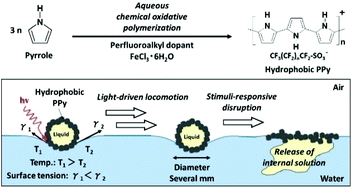Hydrophobic polypyrroles synthesized by aqueous chemical oxidative polymerization and their use as light-responsive liquid marble stabilizers†
Abstract
Hydrophobic polypyrroles were synthesized by aqueous chemical oxidative polymerization in the presence of perfluoroalkyl dopants with various perfluoroalkyl chain lengths in a single-step, one-pot manner. The resulting polypyrroles were extensively characterized with respect to morphology, surface/bulk chemical composition, density, thermal properties, wettability to water and conductivity. Scanning electron microscopy studies indicated that the polypyrroles consisted of flocs of submicrometer-sized primary particles. X-ray photoelectron spectroscopy and contact angle measurement studies confirmed that the perfluoroalkyl dopants existed on the surface of dried polypyrroles and that an increase in the carbon atom number of the dopants led to an increase in water-repellent character. The conductivity of pressed pellets measured by a four-point probe method indicated conductivities ranging from 16.3 ± 2.5 S cm−1 to 3.5 ± 0.1 S cm−1, values higher than those of chloride-doped polypyrroles. The resulting polypyrrole was able to function as a liquid marble stabilizer with photothermal properties. The liquid marble exhibited locomotion due to Marangoni propulsion on a planar water surface after irradiation with a near-infrared laser.



 Please wait while we load your content...
Please wait while we load your content...